Showing Spotlights 1977 - 1984 of 2782 in category All (newest first):
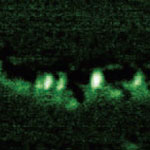 It its more than 25 years of existence, Scanning Tunneling Microscopy has predominantly brought us extremely detailed images of matter at the molecular and atomic level. The Scanning Tunneling Microscope (STM) is a non-optical microscope that scans an electrical probe over a surface to be imaged to detect a weak electric current flowing between the tip and the surface. It allows scientists to visualize regions of high electron density and hence infer the position of individual atoms and molecules on the surface of a lattice. Now, researchers in Japan have managed to partially sequence a single DNA molecule with a STM - a significant step towards the realization of electronic-based single-molecule DNA sequencing.
It its more than 25 years of existence, Scanning Tunneling Microscopy has predominantly brought us extremely detailed images of matter at the molecular and atomic level. The Scanning Tunneling Microscope (STM) is a non-optical microscope that scans an electrical probe over a surface to be imaged to detect a weak electric current flowing between the tip and the surface. It allows scientists to visualize regions of high electron density and hence infer the position of individual atoms and molecules on the surface of a lattice. Now, researchers in Japan have managed to partially sequence a single DNA molecule with a STM - a significant step towards the realization of electronic-based single-molecule DNA sequencing.
Aug 12th, 2009
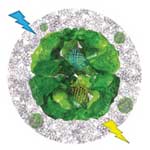 The term bio-interface describes the boundary between synthetic materials such as plastics, and biological systems. This rapidly growing research area, where biology and material sciences overlap, is creating new opportunities for the design, synthesis, and optimization of biologically-enabled and biologically-inspired materials. It involves manufacturing and characterization of functional surfaces for specific interactions with bio-systems and studies of the molecular and kinetic processes occurring at such interfaces, ranging from small molecule and biomolecular interactions, to cell adhesion, differentiation and tissue formation at the interface. For example, the incorporation of proteins into polymers can result in hybrid materials that combine the properties of the polymer as a cost-effective and easy to process material with the highly evolved biological functionality of the protein, enabling new concepts for construction of sensors and biomedical materials. While researchers so far have been focusing on altering the properties of a polymer by adding the functionality of a biomolecule, a group in California has now demonstrated the reverse situation, where changes in the polymer can alter the properties of the protein.
The term bio-interface describes the boundary between synthetic materials such as plastics, and biological systems. This rapidly growing research area, where biology and material sciences overlap, is creating new opportunities for the design, synthesis, and optimization of biologically-enabled and biologically-inspired materials. It involves manufacturing and characterization of functional surfaces for specific interactions with bio-systems and studies of the molecular and kinetic processes occurring at such interfaces, ranging from small molecule and biomolecular interactions, to cell adhesion, differentiation and tissue formation at the interface. For example, the incorporation of proteins into polymers can result in hybrid materials that combine the properties of the polymer as a cost-effective and easy to process material with the highly evolved biological functionality of the protein, enabling new concepts for construction of sensors and biomedical materials. While researchers so far have been focusing on altering the properties of a polymer by adding the functionality of a biomolecule, a group in California has now demonstrated the reverse situation, where changes in the polymer can alter the properties of the protein.
Aug 11th, 2009
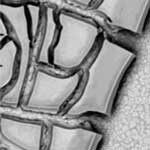 In today's Spotlight we take a look at a specific example of the challenges researchers face in improving fuel cell technology and the important role that modern laboratory instruments such as electron microscopes play in their work. Fuel cells have gained a lot of attention because they provide a potential solution to our addiction to fossil fuels. Energy production from oil, coal and gas is an extremely polluting, not to mention wasteful, process that consists of heat extraction from fuel by burning it, conversion of that heat to mechanical energy, and transformation of that mechanical energy into electrical energy. In contrast, fuel cells are electrochemical devices that convert a fuel's chemical energy directly to electrical energy with high efficiency and without combustion (although fuel cells operate similar to batteries, an important difference is that batteries store energy, while fuel cells can produce electricity continuously as long as fuel and air are supplied).
In today's Spotlight we take a look at a specific example of the challenges researchers face in improving fuel cell technology and the important role that modern laboratory instruments such as electron microscopes play in their work. Fuel cells have gained a lot of attention because they provide a potential solution to our addiction to fossil fuels. Energy production from oil, coal and gas is an extremely polluting, not to mention wasteful, process that consists of heat extraction from fuel by burning it, conversion of that heat to mechanical energy, and transformation of that mechanical energy into electrical energy. In contrast, fuel cells are electrochemical devices that convert a fuel's chemical energy directly to electrical energy with high efficiency and without combustion (although fuel cells operate similar to batteries, an important difference is that batteries store energy, while fuel cells can produce electricity continuously as long as fuel and air are supplied).
Aug 6th, 2009
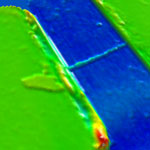 The degree of mobility of a semiconductor, i.e. how well it conducts, is crucial to the effectiveness of nanoelectronic devices. Mobility determines the carrier velocity, and hence switching speed, in FETs. Researchers have determined that the theoretical mobility of an individual single-walled carbon nanotube is about 1000 times higher than any other known semiconductor. However, practical applications would require massive manufacturing of large scale nanoelectronic devices. Despite progress being made with integrating individual nanotubes in lab environments, many of today's nanomanufacturing techniques for nanoelectronic devices rely on the use of 'carbon nanotube network films' comprised of multiple carbon nanotubes. The major problem here is that the electronic properties of CNT network films are usually very poor. Researchers in South Korea have now developed a powerful strategy to solve these fundamental problems simply by controlling the connectivity of nanotube/nanowire networks.
The degree of mobility of a semiconductor, i.e. how well it conducts, is crucial to the effectiveness of nanoelectronic devices. Mobility determines the carrier velocity, and hence switching speed, in FETs. Researchers have determined that the theoretical mobility of an individual single-walled carbon nanotube is about 1000 times higher than any other known semiconductor. However, practical applications would require massive manufacturing of large scale nanoelectronic devices. Despite progress being made with integrating individual nanotubes in lab environments, many of today's nanomanufacturing techniques for nanoelectronic devices rely on the use of 'carbon nanotube network films' comprised of multiple carbon nanotubes. The major problem here is that the electronic properties of CNT network films are usually very poor. Researchers in South Korea have now developed a powerful strategy to solve these fundamental problems simply by controlling the connectivity of nanotube/nanowire networks.
Aug 4th, 2009
 Much attention of nanotechnology researchers has recently been paid to the fabrication of free-standing, ultra-thin films. These systems have been developed for use in a wide variety of fields such as nano-separation membranes or nanosensors for electrochemical and photochemical applications. In a first report on the fabrication of free-standing nanosheets for biomedical applications, scientists in Japan have developed a biodegradable thin film of only about 20 nanometers thickness that could replace surgical stitches. In experiments, they found that the sealing operation repaired the incision completely without scars and tissue adhesion. This approach would constitute an ideal candidate for an alternative to conventional suture/ligation procedures, from the perspective not only of a minimally invasive surgical technique but also reduction of operation times.
Much attention of nanotechnology researchers has recently been paid to the fabrication of free-standing, ultra-thin films. These systems have been developed for use in a wide variety of fields such as nano-separation membranes or nanosensors for electrochemical and photochemical applications. In a first report on the fabrication of free-standing nanosheets for biomedical applications, scientists in Japan have developed a biodegradable thin film of only about 20 nanometers thickness that could replace surgical stitches. In experiments, they found that the sealing operation repaired the incision completely without scars and tissue adhesion. This approach would constitute an ideal candidate for an alternative to conventional suture/ligation procedures, from the perspective not only of a minimally invasive surgical technique but also reduction of operation times.
Jul 31st, 2009
 Many of the properties of a given nanoparticle not only depend on its chemical composition but also on its size and shape, i.e. its morphology. These morphological factors have significant impact on a nanoparticle's optical and catalytic properties. Accordingly, nanoparticle manufacturers have developed numerous 'recipes' for synthesizing particles with desired size and shape. To facilitate systematic investigation on the morphology-property relationship, it would be highly desirable if one reaction system can be engineered to yield as many different shapes as possible with minimal degree of parameter tuning. To that end, researchers proposed a way to systematically engineer the morphologies of nanoparticles by constructing an evolutionary tree, which consists of several pathways, each showing a 'string' of evolving shapes over the courses of a single reaction. The tree not only displays the relationship between different shapes, but also offers designing principles for producing more complex shapes by crossing over different pathways during nanoparticle growth.
Many of the properties of a given nanoparticle not only depend on its chemical composition but also on its size and shape, i.e. its morphology. These morphological factors have significant impact on a nanoparticle's optical and catalytic properties. Accordingly, nanoparticle manufacturers have developed numerous 'recipes' for synthesizing particles with desired size and shape. To facilitate systematic investigation on the morphology-property relationship, it would be highly desirable if one reaction system can be engineered to yield as many different shapes as possible with minimal degree of parameter tuning. To that end, researchers proposed a way to systematically engineer the morphologies of nanoparticles by constructing an evolutionary tree, which consists of several pathways, each showing a 'string' of evolving shapes over the courses of a single reaction. The tree not only displays the relationship between different shapes, but also offers designing principles for producing more complex shapes by crossing over different pathways during nanoparticle growth.
Jul 29th, 2009
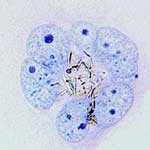 One of the complications of nanotoxicology is that the toxicity of a specific nanomaterial cannot be predicted from the toxicity of the same material in a different form. For instance, while the toxicity of inert systems such as iron oxides, gold, or silver has been investigated for nearly isotropic particles, the toxicity of these materials in nanofilament form cannot be predicted from their known toxicity as nanoparticles. Fully understanding the toxic mechanisms of nanoscale materials is an essential prerequisite in being able to design harmless nanomaterials whose interactions with biological cells is non-lethal. Currently, a lot of nanotoxicological research effort is focused on carbon nanotubes, but nanofilaments are not exclusively based on carbon materials and can be produced from many inorganic materials in the form of nanotubes and nanowires. Applying the 'precautionary principle' to nanotechnology would require much more extensive nanotoxicological research on all types of nanomaterials; and there seems to be a particular lack of findings concerning non-carbon nanofilaments. Researchers in Switzerland have now taken a closer look at the fate of titanium dioxide (TiO2) based nanofilaments in the body. Their results are cause for concern.
One of the complications of nanotoxicology is that the toxicity of a specific nanomaterial cannot be predicted from the toxicity of the same material in a different form. For instance, while the toxicity of inert systems such as iron oxides, gold, or silver has been investigated for nearly isotropic particles, the toxicity of these materials in nanofilament form cannot be predicted from their known toxicity as nanoparticles. Fully understanding the toxic mechanisms of nanoscale materials is an essential prerequisite in being able to design harmless nanomaterials whose interactions with biological cells is non-lethal. Currently, a lot of nanotoxicological research effort is focused on carbon nanotubes, but nanofilaments are not exclusively based on carbon materials and can be produced from many inorganic materials in the form of nanotubes and nanowires. Applying the 'precautionary principle' to nanotechnology would require much more extensive nanotoxicological research on all types of nanomaterials; and there seems to be a particular lack of findings concerning non-carbon nanofilaments. Researchers in Switzerland have now taken a closer look at the fate of titanium dioxide (TiO2) based nanofilaments in the body. Their results are cause for concern.
Jul 27th, 2009
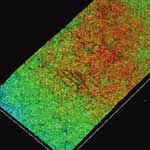 Developing bioassays that are simple, portable, disposable and inexpensive will provide important tools to rapidly detect toxic substances. This technology could also be extremely useful in monitoring environmental and food-based toxins in remote settings such as less industrialized countries where these tools are essential for the first stages of detecting disease settings and where the time and expense of using sophisticated instrumentation would be prohibitive. To that end, researchers have developed simple, portable, disposable, and inexpensive paper-based solid-phase sensors to run multiple bioassays and controls simultaneously. Bioactive paper is any low-cost and easy-to-use paper product laced with biologically active chemicals that provides a rapid way to detect toxins like E. coli bacteria and salmonella, or pathogens such as SARS or influenza.
Developing bioassays that are simple, portable, disposable and inexpensive will provide important tools to rapidly detect toxic substances. This technology could also be extremely useful in monitoring environmental and food-based toxins in remote settings such as less industrialized countries where these tools are essential for the first stages of detecting disease settings and where the time and expense of using sophisticated instrumentation would be prohibitive. To that end, researchers have developed simple, portable, disposable, and inexpensive paper-based solid-phase sensors to run multiple bioassays and controls simultaneously. Bioactive paper is any low-cost and easy-to-use paper product laced with biologically active chemicals that provides a rapid way to detect toxins like E. coli bacteria and salmonella, or pathogens such as SARS or influenza.
Jul 24th, 2009
 It its more than 25 years of existence, Scanning Tunneling Microscopy has predominantly brought us extremely detailed images of matter at the molecular and atomic level. The Scanning Tunneling Microscope (STM) is a non-optical microscope that scans an electrical probe over a surface to be imaged to detect a weak electric current flowing between the tip and the surface. It allows scientists to visualize regions of high electron density and hence infer the position of individual atoms and molecules on the surface of a lattice. Now, researchers in Japan have managed to partially sequence a single DNA molecule with a STM - a significant step towards the realization of electronic-based single-molecule DNA sequencing.
It its more than 25 years of existence, Scanning Tunneling Microscopy has predominantly brought us extremely detailed images of matter at the molecular and atomic level. The Scanning Tunneling Microscope (STM) is a non-optical microscope that scans an electrical probe over a surface to be imaged to detect a weak electric current flowing between the tip and the surface. It allows scientists to visualize regions of high electron density and hence infer the position of individual atoms and molecules on the surface of a lattice. Now, researchers in Japan have managed to partially sequence a single DNA molecule with a STM - a significant step towards the realization of electronic-based single-molecule DNA sequencing.
 Subscribe to our Nanotechnology Spotlight feed
Subscribe to our Nanotechnology Spotlight feed





